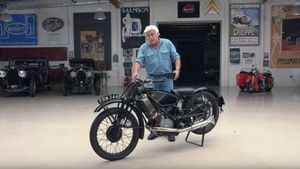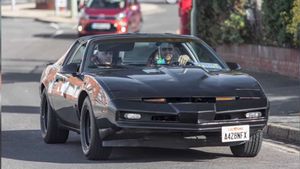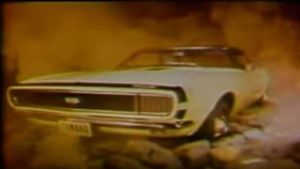Designed to tackle the treacherous conditions of Antarctica in 1939, America's Snow Cruiser – still missing in action – remains one of history's greatest engineering legends. But what went wrong?
Known to us mere mortals as the Snow Cruiser, and causing tailbacks along a 1020-mile route stretching from Chicago to Boston, this massive exploration machine represented the US attempt at taking possession of Antarctica in late 1939. However, things didn't quite go according to plan.
More 1930s Wonders!
- This 1937 Packard V8 Offers Old School Styling With Modern Power
- Unique 1938 Mercedes-Benz 540K Wins Amelia Island Best In Show
- This Is The 1932 Ford That Made Hot Rods Famous
In the run up to WWII, declaring large chunks of the unclaimed continent had become something of a sport for decedent adventurers – and America's social elite wanted in. Except, with cash to develop new transport, they weren't simply going to walk. Oh, dahling, no.
Designed by physicist and explorer Thomas C. Poulter, and constructed by the Armour Institute of Technology in Chicago, the Snow Cruiser was staggeringly large. Some seventeen metres in length, six metres wide and five metres in height when standing atop impossibly large pneumatic tyres – even by modern standards, this was a force to be reckoned with.

Having such a notable vehicle, boasting a price tag of $150,000 back in 1938 ($2.8 million with modern inflation), demonstrated clear intent from the US on asserting its ownership of various sectors of the polar region, but why?
There was much at stake within Antarctica. Conquering these frozen lands was an irresistible challenge that would bring much admiration and respect to those who were successful. There were invaluable opportunities for scientific study with the possibility of establishing weather observatories that would greatly assist with long-term forecasting. And who wouldn’t be interested in enormous reserves of coal, oil, copper, tin and nickel beneath the snow?
Funnily enough, the US was keen to snatch a generously proportioned slice of the pie; especially with tense global relations as Adolf Hitler marched his armies across Europe. Many spots had already been claimed for America, by Lincoln Ellsworth and Rear Admiral Richard E. Byrd on previous expeditions, but those in power wanted more of a physical presence on Antarctica – thus the need for a research vehicle.

Consequently, the Snow Cruiser was enormous for one main reason. Not only did she have to provide accommodation for several men, but she also had to serve as a mobile scientific laboratory and competent polar exploration vehicle.
The Snow Cruiser carried 2500 gallons of diesel for powering itself, as well as 1000 gallons of aeroplane fuel for the Beechcraft Staggerwing Scout bi-plane, used to conduct aerial surveys, that it would carry on the roof.
Such weight required enormous structural strength, provided by a framework and steel skin constructed from Inland Hi-Steel, which was then coated in bright red paint to ensure the vehicle would be easily spotted from aircraft above. Naturally, it would have been foolish to set off on such a treacherous journey without reserve tyres; so two 10-foot high spares were carried in a rear compartment.

But sheer bulk and jaw-dropping proportions weren’t going to be enough for a successful Antarctic mission. It was anticipated that the Snow Cruiser would drive across uncharted ice fields and scale polar mountains, as well as having to straddle numerous deep and dangerous crevasses.
Power was provided by a diesel-electric hybrid, which consisted of two 150bhp Cummins H-6 diesel engines, powering individual generators running electric motors contained within each wheel hub. Now commonplace in modern mining trucks, this was likely the first use of a diesel-electric powertrain in such a large vehicle.
The wheels themselves could be retracted back up inside the long body overhangs when progress-halting crevasses presented themselves. The front set of wheels could be raked in, while the rear wheels used their contact with the ground to push the front end of the Snow Cruiser over each gap. Once straddling the crevasse, the method would be repeated for the rear wheels, as the front set propped themselves back up. It was an innovative, and unique, system.

To further enable the Snow Cruiser to progress, despite a whole range of testing obstacles, it came fitted with four-wheel steering that was controlled by two levers, rather than the conventional steering wheel. The hydraulic system operated with a 30-foot turning circle, using rams at 15,000 pounds pressure to minimise potential breakages.
These combined features made the Snow Cruiser a technological marvel that captured public imagination. Possessing a number of innovative features, the exploration vehicle was dream material for a wide range of scientific and engineering publications. Amongst them was Popular Science who, in November 1939, published detailed cut-away diagrams so those with mechanical curiosity could devour them.

It's no wonder then, that as the enormous Snow Cruiser left its Chicago construction yard on 24th October 1939, it was destined to enjoy a memorable journey towards the awaiting ship bound for Antarctica shores.
From Chicago to Boston, also taking in New York on the route, the world came to a grinding halt as the red leviathan passed by. Streets and roads were lined with thousands of inquisitive people dominating the roadside.
Chances are, before it had even navigated one single street, it would have both astonished and held up other drivers on the road. After all, it’s not very often that a vehicle is so large that it requires both lanes. Anyone else on the same road as the Snow Cruiser had no option but to pull off the tarmac and simply let this bizarre automobile through.
Most roads were closed before the Snow Cruiser arrived and, if you caught it up afterwards, you’d likely only be doing 30mph at best. At other points, the Snow Cruiser moved at a snail’s pace and the inevitable delays as the giant navigated tricky obstacles were lengthy.

A week after leaving Chicago, the Snow Cruiser arrived in Ohio and encountered numerous problems within the state. One time-consuming section was a bridge exactly 20-feet wide, leaving a total clearance of only 4 inches. It took three hours and four men, each carefully watching a corner from on top of the Snow Cruiser, to help guide the vehicle safely across.
They didn't have the same success on a small bridge on the Lincoln Highway, when the steering system broke near the town of Gomer and resulted in the Snow Cruiser driving off the bridge into a stream. Hydraulic jacks incorporated into the bodywork partially lifted the Snow Cruiser off the ground, allowing timbers to be placed under the wheels and serve as a ramp back onto the road.
However, thanks to the sheer bulk involved, it wasn’t an easy task and the Snow Cruiser was stuck there for three days meantime.

Unintentionally, the roads served as preparation for the difficulties that lay ahead in Antarctica, with the skill of the men on board thoroughly tested on route to Boston. Perhaps while leaving a 20-mile traffic jam behind in Framingham, Massachusetts, the team were looking forward to carrying out repair work and tackling difficult manoeuvres without the watchful eyes of hundreds of spectators.
It was likely that they finally departed from Boston with a sigh of relief on board the ship North Star on November 15, 1939, setting sail for Little America in the Bay of Whales.

Frustratingly, the Snow Cruiser’s real problems had barely begun and disaster almost struck as soon as the crew tried to disembark from North Star in early January 1940. While descending a timber ramp, about two-thirds of the way down, the front left wheel plunged straight through the wooden structure. The three men guiding the vehicle from atop the roof struggled to hold their footing as the Snow Cruiser dropped and banked to one side. The footage was recorded and can be viewed here.
As those watching stepped back from 34-tonnes hanging off the ramp, the already-open cabin doors sliced forward beyond the windscreen, almost sending one crew member to his doom. After copious amounts of diesel smoke, the Snow Cruiser finally broke free from the crumbled remains of the ramp to some relieved cheers from the spectators below.
However, the supportive shouts from those watching soon tailed off as the ultimate anti-climax presented itself – the smooth tyres were unable to move the Snow Cruiser through the snow and ice.

It is perhaps easy to scoff some eight decades later, now that the on-going development of winter tyres has established that tread, ideally with chunky block edges as well as circumferential and lateral grooves interlaced throughout, is an efficient means of gaining traction on snow and ice.
Even Goodyear, who provided the Snow Cruiser with its rubber, now sell winter tyres with complicated tread patterns that guide snow away from where a car makes contact with troublesome surfaces. Back in 1939 however, the thinking was that tread-less tyres would make an ideal match for the conditions of Antarctica.
This was based on concepts from swamp vehicles and tests carried out in the sand dunes on Lake Michigan. In the experiments, a large truck would sink in the sand to its hubs and had to be towed out – whilst the Snow Cruiser only sunk an inch or so.

The Snow Cruiser sat upon the sand with a contact area of only nine square-feet per tyre and the hope had been this would keep the vehicle out of trouble in the frozen north. Alas, although able to move to some extent, the Snow Cruiser was nowhere near as mobile as hoped.
Getting underway with difficulty, the Snow Cruiser tried to redeem the ambitions of the project. The crew attempted to add the two spare tyres to the front and chains on the rear wheels for increased traction, but their efforts didn’t improve matters by much.
Instead, to their surprise, they found that driving in reverse seemed to work best, notably improving grip. One of the longest trips driven backwards was a whopping distance of 92 miles.

The crew were certainly innovative, but it didn’t help that they had only 300hp at their disposal to tackle lengthy treks through Antarctica. Back when the world was black and white, the Snow Cruiser’s 300hp would have sounded impressive. In most cars now this figure is still admirable, but given there was 34-tonnes of Snow Cruiser to shift, the specification was actually woefully inadequate. That's 8.8hp per tonne.
Reports of the ‘complete flop’ and ‘floundering leviathan’ Snow Cruiser flooded US newspapers and the public’s enthusiasm, so clearly seen on the streets between Chicago and Boston, began to dampen. Regardless of reception back home, the scientific team continued with seismology experiments, taking ice samples and measuring cosmic rays.
By New Year’s Day 1941, the team were simultaneously dealing with heavy snowfall and low fuel gauge readings. Supplies had to be flown in to feed their large team of dogs that had accompanied them so far. After some success in the air, the Beechcraft Staggerwing was taken away on the North Star as the propeller engine had thrown a rod.

The crew opted to settle in one location and covered the Snow Cruiser with packed ice and timbers to help the vehicle retain warmth. They were determined to keep going, but far from the frozen bubble the dogged team were residing in, larger concerns of the possibility of a Second World War were detracting attention and funding away from the Snow Cruiser project.
Eventually, it was decided that the Snow Cruiser would have to be abandoned and the team brought home. Reports say the Snow Cruiser was hidden inside its protective berth with thick sheets shrouding the tyres. It was decided that the Snow Cruiser would have to wait until the horrors of global conflict had passed.
Unfortunately for the Snow Cruiser, the same enthusiasm for the project that had overseen its construction never returned; understandably so, given that some 420,000 Americans had perished throughout WWII. The eerie shadows of war took many years to lift, by which time the ambitious U.S. Antarctic Service program had largely been forgotten.

The Snow Cruiser was found twice after this time. In late 1946, an expedition team from the US Navy’s Operation Highjump found the relinquished vehicle and reported back. Apparently, all the Snow Cruiser would require to once again function was some basic servicing and the tyres pumped back up.
Some twelve years later, the Snow Cruiser was once again discovered thanks to a marker pole, albeit hidden under several feet of snow. The 1958 expedition team dug down to the bottom of the wheels and were able to get inside, where they found magazines, papers and cigarettes from the original crew.
At this point, the vehicle housed several men from the 1958 exploration team, who found the Snow Cruiser's refuge to be superior to the shelters provided. However, while the systems were not started, the team inspected the drivetrain and claimed that very little would be required to get things going again.

This was the last time the Snow Cruiser would be found. Later expeditions tried, but failed, to find the ageing relic of 1930s and 1940s Antarctic exploration. Geologists have suggested that the Snow Cruiser may have sunk to the bottom of the ocean after a significant chunk of the Ross Ice Shelf broke off in the mid-1960s. The eastern barrier section of this shelf was home to the Snow Cruiser’s berth and may have been lost as the break tore across 'Little America' - the US exploration base.
Elsewhere, some conspiracy theories have also emerged on the Snow Cruiser’s disappearance, including the possibility that the Soviet Union could have smuggled the vehicle out during the Cold War.

Either way, what is certain about the Snow Cruiser is that it whole-heartedly represented the greatest of American ambition. Although the vehicle encountered numerous difficulties both on the road and upon the treacherous surface of Antarctica, it successfully made use of several innovative concepts for the first time.
The Snow Cruiser remains proof of mankind’s desire to push beyond our comfort zone and to strive for new scientific discoveries. Although now missing in action, the lost Snow Cruiser continues to stoke imagination and epitomise the very essence of pre-war exploring.





